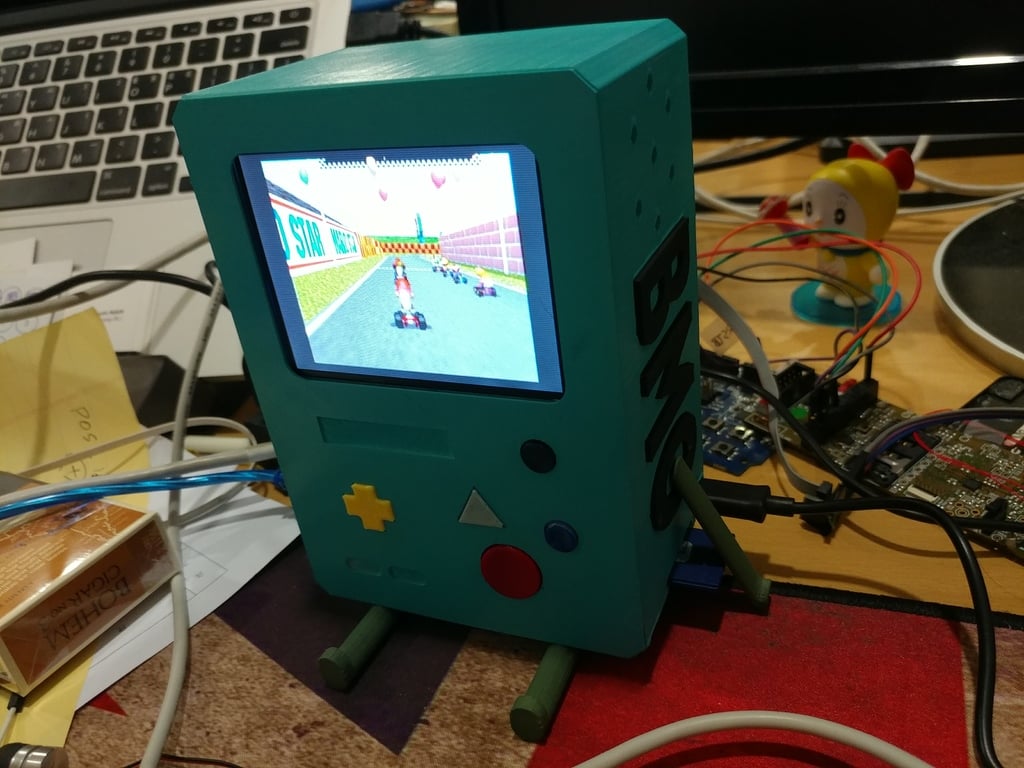
BMO Shaped case for Raspberry Pi 1 B
thingiverse
Working on a Raspberry Pi 1 B+ case that I designed myself. Here's a working video: https://youtu.be/n1TOkIIqKnI. I started this project to create a nice case for my existing Raspberry Pi 1B+. I used to use it as a KODI machine for my old TV, but while making the case, I decided to add more features like sensor connections for monitoring air quality and environmental parameters. To display these readings on my BMO Raspberry Pi screen, I added a 3.5-inch rear view monitor from Aliexpress. To make assembly easier, I divided the main parts into five pieces, including some small buttons, arms, legs, BMO letters, and guide brackets. You can build BMO with the main five parts and buttons without making a reset button or screen if you don't want to. The screen can be replaced with paper or an acrylic panel; it's up to you. I soldered two points on the board for the reset switch and composite cable. I used a 5V-12V step-up converter board to power the screen, which could work with 5V if modified slightly. However, I chose not to solder much and decided to use the converter instead. Connecting the reset switch: Raspberry Pi provides a reset jumper by default, but it's not connected. Solder a jumper head on JP6 and add a tactile (push) switch. I recommend using a 12mm×12mm square-head push button for my design. Only reset and wake-up from halt were enough for me; if you need more functions like safe shutdown, refer to the link below. http://www.raspberry-pi-geek.com/Archive/2013/01/Adding-an-On-Off-switch-to-your-Raspberry-Pi Screen: To save GPIO, I didn't use the screen using GPIO parallel connection. Instead, I chose a 3.5-inch LCD screen for car rearview monitors and connected power and composite video signals. Many 3.5" composite screens are sold on the market; I recommend using one with a small controller board like this: http://sudomod.com/wp-content/uploads/2016/04/IMG_2572.jpg Power source for the monitor: I used a 5V-12V step-up converter, which you can easily find on the market. It doesn't have to be exactly the same as mine, but I recommend using one that supports 1A. Solder a jumper to the composite signal pin (with or without the composite connector desoldered). Sound: Initially, I directly soldered a small speaker to the analogue audio output port, but the signal strength from the analogue audio port was not enough to drive the speaker to make loud sounds. So, I decided to connect an amp in the middle. You can easily find an amp board with a volume knob for around $1.5. From the specification, the impedance of the audio amp is 4ohm, but it works fine with my 8ohm speaker. If you use Raspberry Pi with TV and don't need good sound quality, you can ignore this. Refer to this image: http://img.dxcdn.com/productimages/sku_419649_3.jpg Showing BMO's face during boot procedure: My BMO shows two different faces while booting. The first one is enabled by the Retropie setup menu. And I found another way to enable the splash screen at a different moment; see the link below. For images of BMO's faces, you can easily find them on the internet or make your own. But you need to resize or change the resolution setting to show it correctly. 1920x1080 is recommended for the image resolution. Recommended screws for assembling: I used two different screws to assemble BMO case and tighten the board on the bottom panel. Both are M3 screws, but the length of the screws is different. I used 6mm-length screws to tighten the front, bottom, back, and side panels, and 4mm-length screws were used for tightening the back cover on the back panel. To put the Raspi board on the bottom panel, both lengths are okay. I recommend using flat-head screws to make the case look better. I used M3 screws from a Thinkpad laptop; you can easily find sellers on Amazon.com or Aliexpress.com. This is still a working project. I will update the bill of materials I used, add more models for RPi 3, and sensors when they are done. If you have any comments or suggestions, please let me know.
With this file you will be able to print BMO Shaped case for Raspberry Pi 1 B with your 3D printer. Click on the button and save the file on your computer to work, edit or customize your design. You can also find more 3D designs for printers on BMO Shaped case for Raspberry Pi 1 B.
